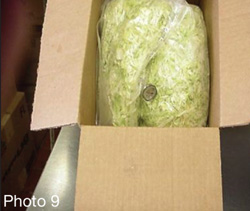To the majority of consumers, food safety means that there is no danger to them from pathogenic microorganisms, naturally occurring toxins, or any other potentially harmful chemicals that may be unintentionally or deliberately added to foods. This is non-negotiable. To businesses in the food industry, food safety is therefore among the most crucial of missions. Of course, a catastrophic failure in fulfilling that mission at any point along the ingredient supplier-processor-distributor-foodservice supply chain may result in devastating economic consequences and irreparable harm to the brand.
However, the more significant driver of the food industry’s mission is really a moral imperative: To provide food, the sustenance of life, that is safe and wholesome to all. That imperative extends to ensuring that we use food safety best practices in the transportation and distribution of foods. It does the processor little good if they’ve manufactured product with the highest food safety protocols in place but their end-customer restaurant receives temperature abused or damaged product at the receiving end. Similarly, the foodservice establishment has a responsibility to handle product deliveries with food safety standards in mind and thus preserve the integrity of the product all the way through to the consumer. These two links in the supply chain—processor and foodservice—can drive improved food safety best practices by working in partnership with the link in the middle: the distributor.
A lot of things can happen to food products between the processor’s shipping dock and the restaurant location’s back door or the food retailer’s receiving dock. Product can be physically damaged, temperature abused, exposed to unsanitary conditions and numerous other undesirable conditions that can and do result in increased risk of microbiological, chemical or physical hazards. Working with reputable distributors who are dedicated to and consistently apply food safety best practices throughout their operations—from truck to warehouse to delivery—is key to mitigating food safety and quality risks through the point of use by consumers.
Restaurant operators like Popeyes Chicken & Biscuits, for example, receive thousands of loads of food products each day at various establishments the world over. To illustrate some of the ways in which the partnership between the distributor and the foodservice operator can improve food safety and quality, we’ll first consider some of the top ways distributors can establish best practices to mitigate related risks during transport and distribution, and then we’ll look at how the foodservice operation receiving those goods can do the same.
On the Road to Best Practices
There are eight essential components that food distributors should include as part of their quality assurance/quality control systems to be considered proactive partners in food safety by their customers in foodservice and retail. These are:
• Good Food Handling Practices
• Proper Personnel Training (Good Manufacturing Practices)
• Good Cleaning and Sanitation Practices
• Effective Pest Control Program
• Proactive Shipping and Receiving Programs
• Recall Program
• Hazard Analysis and Critical Control Points (HACCP) Program
• Institute a Food Defense Program
By working closely with their customers upstream in processing and downstream in foodservice/retail, food distributors will be well-equipped to develop and implement food safety best practices and protocols that are closely aligned with the requisites of their partner companies. These companies will have the best opportunity to land and keep contracts for service, and in some cases, gain preferred provider status with customers that have such programs in place. Of course, many of these best practices also apply to food processor/suppliers.
1. Good Food Handling Practices. It is important that transporters and distributors establish sanitary food handling practices for trucks and carrier vehicles, storage areas and warehouses. Three of the most critical areas are as follows:
• Maintaining proper storage temperatures in warehouses and aboard shipping carrier vehicles. No matter how high the level of integrity of the finished product leaving the manufacturing plant, if that product is not stored in the warehouse or transported in the truck at the correct temperature, the safety of the food will be compromised. Currently, this is a tremendous concern associated with the shipping carriers due to skyrocketing fuel costs. When transporters attempt to reduce fuel costs by shutting off the refrigeration systems in the truck trailer, the product clearly will undergo some level of temperature abuse, perhaps to a level that allows the growth of undesirable pathogenic organisms in or on the product or packaging.
Distribution companies should ensure that all personnel who handle food product containers, including warehouse forklift drivers, loaders and truckers, understand the adverse effects of temperature abuse and establish clear protocols to ensure that product is stored and travels at the proper temperature in order to maintain its integrity, both in terms of food safety and quality.
• Ensure proper identification and segregation of damaged, rejected, expired and on-hold products. This may seem simplistic but ensuring that employees check that they are handling the right product for the order prevents mix-ups at the receiving end that can adversely affect the proper rotation or segregation of product, which in turn can compromise both safety and quality. On the quality side, for example, spices that are past their use-by date may have undergone oxidation that affects the flavor profile in a negative way. On the safety side, the distributor wants to make sure that foods that are “on hold,” such as those waiting for microbiological test results to clear, are not mistakenly released from the warehouse and sent to a foodservice establishment. Clearly, if the tests show some microbial adulteration of the product after the establishment has prepared and served food items to consumers, the situation could put people at risk of foodborne illness, or worse.
At the end of the day, distributors should have in place a system of inventory checks and similar protocols for identifying and tracking product to prevent damaged, rejected, expired or on-hold items from entering the distribution channel.
• Make sure that raw products are segregated from finished products in storage and shipping vehicles. Again, it is imperative that all persons handling food products in the distribution warehouse or transport vehicles understand that in no instance should raw product be stored or placed near finished product. The risk of cross-contamination is too high.
2. Proper Personnel Training. Establishing training programs for all employees in good sanitation, personal hygiene and food handling procedures and practices is key to achieving the highest levels of food safety in any operation in the food supply chain. In transportation and distribution operations the basic topics that should be covered and routinely reinforced in food safety training programs are essentially the same as we would expect in the processing plant or the restaurant establishment, including:
• Enforcement of personnel hygiene. Stringent policies regarding hygienic practices by all personnel should be in place in all distribution facilities. Warehouse employees should wear clean clothes and footwear, use hairnets when appropriate, and in some situations, limit wearing jewelry or other accessories when at work. These practices help keep the storage environment clean, which can significantly reduce potential hazards from entering the facility in the first place.
Requiring employees to practice proper handwashing techniques is also important, even in the warehouse. Dirty hands bring disease, and the transfer of bacteria, viruses, chemical residues or even soils onto food packages, boxes or containers carry a risk of cross-contamination to actual product when those boxes or packages are eventually opened—or for some opportunistic bugs, transferred from the outer container to the warehouse environment itself (i.e., floors, walls, drains or forklifts). Similarly, personnel should be discouraged from coming to work if they are ill or suspect they are ill.
• Establish proper training in food handling procedures. For example, the foodservice customer does not want the distributor’s personnel to throw the product around and damage it. Some products are very sensitive, and if such items get smashed or crushed and their packaging is torn or opened, microorganisms now have the opportunity to enter, grow and multiply.
• Proper training in cleaning and sanitation procedures and practices. It is also a good idea to ensure that employees understand the importance of mitigating food safety hazard risk through proper sanitation. The foodservice customer does not want to visit the distribution facility and see that food products scheduled to be delivered to restaurants are stored in a filthy warehouse, or that the truck that is being used to transport foods is unsanitary.
3. Good Cleaning and Sanitation. Before personnel can be trained in proper cleaning and sanitation procedures, however, the distributor must establish these good practices. First, distributors should have a regular cleaning schedule in place for all storage facilities, warehouses and shipping carrier vehicles. The company should work with a good cleaning chemical supplier to ensure that sanitarians are using the right detergents and sanitizers for their environments (i.e., refrigerated versus dry storage facility), in the right concentrations and at the right frequency for optimal sanitation.
In addition, procedures should be established for proper detergent and sanitizer use, application and storage to prevent chemical contamination. There may be security reasons for this, and of course, cleaning chemicals should never be stored next to food products or packaging. Material Safety Data Sheets (MSDSs) for cleaners and sanitizers should be in place as a matter of course, and employees should receive training in the safe preparation and handling of sanitation chemicals for their safety and the safety of others.
4. Pest Management/Control Program. A good pest management program addresses the food safety hazards posed by birds, rodents and insects. Distribution warehouses can be very large facilities holding several thousands of pallets of food product containers at any given time. Eliminating to the best of your ability any harborage areas for insects and rodents that can do untold amounts of damage to containers, and preventing birds that can spread Salmonella from roosting and flying over the distribution area is imperative. It is a good idea to contract the professional services of a licensed pest control company with professional technicians who know how to safely apply pest control chemicals or other techniques that are appropriate to a food handling environment. Similarly, distributors should include vehicles in routine pest inspections. Again, MSDSs for pest control chemicals should be available, and protocols in place for the proper storage of these chemicals.
5. Receiving and Shipping Programs. Since the Bioterrorism Act of 2002 was passed, the food supply chain has perhaps never before been more focused on traceability, although track-and-trace systems have long been a part of the industry’s food safety programs. Essentially, all food companies need to know what they are sending and receiving at all times, and they are required to implement the associated record-keeping practices involved in such programs. All food companies need to record information, including the condition of the product, the temperature, the lot numbers, code dates and kill dates, to facilitate immediate trace-and-track activities should this become necessary. Compliance with the requirements of the Bioterrorism Act is a challenge for all segments of the food industry and distributors are expected to record and keep this information just as others in the industry.
In addition to good recordkeeping, cleanliness and organization in receiving/shipping areas and in shipping carrier vehicles goes a long way toward preventing products from being shipped to the wrong destination and enhancing your ability to quickly locate items in the warehouse (or on the road, if they’ve been shipped).
Good receiving/shipping programs adhere to a “first in/first out (FIFO) rotation policy, so that product that arrives first at the warehouse is shipped first. Distributors should ship product immediately and not store it too long in the warehouse to avoid product loss due to a product’s shelf life expiring before it reaches its final destination and results in happier customers who want the freshest product in their restaurants.
6. Product Recall/Withdrawal Program. Again, all food companies, including food transportation and distribution operations, should have recall/withdrawal procedures in place. Manuals should be updated routinely to include the names and contact information of responsible parties to contact in the event of a recall, including emergency or after-hours phone numbers. Instituting mock recall programs is also a good idea because these exercises help to determine whether the operation’s policies and procedures are working and/or identify any potential problems to be corrected before they rise to the level of a recall situation.
7. HACCP. Distributors should maintain complete records and files of in-house handling of products from the time of receipt to the time of delivery to restaurants. HACCP is a well recognized preventive program designed to identify and mitigate or eliminate food safety hazards throughout processing and handling that requires of its practitioners excellent record keeping practices and thorough documentation. Thus, complete HACCP records help maintain the food safety chain, since they are provided from the food manufacturer to the distributor when product is loaded at the processing plant shipping dock, and then passed on from the distributor to the restaurant or retail operation. Distributors and suppliers/processors should maintain complete shipping carrier inspection logs in order to facilitate traceback should a problem arise.
8. Food Defense Program. Again, full compliance with the requirements of the Bioterrorism Act is expected and distributors are expected by their customers downstream to have conducted a food security risk assessment and to have implemented any physical security measures or systems necessary in terms of vehicles, warehouses and other facilities. For example, buildings should be secure and locked, cameras may need to be installed to deter lawbreakers, and truck trailers should not be left open when unsupervised to prevent potential product tampering. Other elements of the defense program should include shipping and receiving security as discussed; storage security; water and ice security; mail handling security; and personnel security. The distributor’s food defense plan should be available to customers and documented thoroughly.
The Restaurant’s Role in Good Distribution
The distributor’s customers also have responsibilities to ensure that the integrity of the product is maintained at the point of delivery, and into and through the back door of every receiving location. The foodservice operator can contribute greatly in ensuring that food is safe in transport and distribution channels in a number of important ways, including:
• Establish Product Specifications
• Audit Suppliers’/Processors’ and Distributors’ Facilities
• Establish Delivery Transportation Audit Program
• Monitor Product Temperature During Shipping
• Train and Educate Restaurant Personnel
1. Product Specifications. Restaurants need to establish clear product specifications that outline the expectations for acceptable product. Suppliers are typically expected to provide to their foodservice customers a complete product description, ingredient statement (i.e., an allergen alert, if applicable), and documentation (or in some cases, certificates of analysis [COAs]) pertaining to physical, chemical or microbiological attributes of the shipped product to ensure that the right product has arrived at the establishment and that all product delivered meets the agreed acceptability parameters for food safety and quality. Also, the supplier/processor will be required to provide proper and legible packaging, labeling and coding information for traceability with the following data points: manufacturing date; use-by date; batch and chub numbers; kill date; time of production; production line ID; and processing plant number. Also, the distributor will need to provide proper records that show transportation and warehouse personnel have complied with all storage, shipping, shelf life and product handling guidelines, as outlined by the foodservice customer.
Of course, the foodservice company also will establish product specifications pertaining to formulation, processing and packaging procedures, quality assurance requirements, and HACCP program requirements. With regard to the latter, it is a given that CCPs have been addressed and that documentation is available to show that product has been cleared for shipping by the supplier/processor as meeting HACCP requirements. It is highly recommended that distributors institute their own HACCP programs to maintain the chain of proactive food safety hazard prevention for product in storage and all the way through transit and delivery.
2. Audit Suppliers’/Processors’ and Distributors’ Facilities. One of the best ways to gain a high level of confidence that goods arriving at the foodservice establishment meet product specifications for food safety and quality is to audit the distribution centers. Many foodservice operators require third-party food safety, security and sanitation audits to be conducted and frequently require that the auditing companies used are selected by the distributor from a preferred list of firms approved by the customer. These audits are often scheduled ahead of time and the distributor will have time to prepare staff and the facility before the auditors arrive.
As an extra check, many foodservice customers like Popeyes will conduct unannounced quality assurance audits to ensure that routine food safety, sanitation and security activities are in fact being followed regularly, consistently and according to specifications. Unannounced audits will include evaluation of the real-world implementation of the distributor’s pest control and sanitation programs, receiving and shipping programs, food defense and recall programs, and HACCP/GMPs.
3. Establish a Delivery Transportation Audit Program. The foodservice customer should audit the delivery trucks and/or other food transport vehicles to assess:
• Good product handling practices are followed
• Trailer conditions are acceptable and sanitary
It is important that good food handling practices are applied in and around food transport vehicles to prevent cross-contamination and product/container damage that can lead to increased food hazard risk. As with the distribution facility audit, the foodservice customer should look at the distributor’s food safety, sanitation and security practices. The delivery transportation audit program should include assessments of food handling during loading (i.e., Do trucking personnel know how to segregate raw from finished product? Do they know how to best handle packing containers to prevent damage caused by throwing boxes into the trailer, for example, that can cause openings in which undesirable microorganisms can gain entry? Do they stack boxes in an organized, weight-appropriate manner?). Vehicle/trailer cleaning and sanitation practices should be audited, including general cleanliness or sanitary condition of the trailer in which product is stored during transport, whether it is stored at proper temperatures, and how often it is cleaned and sanitized and with what agents.
Are pest control techniques applied to the trucks, and if so, how often and by what method?
Conducting delivery vehicle audits can identify areas for food safety, quality and sanitation improvements, which can then be communicated through training to drivers, loading and other appropriate personnel. As the photos below evidence, visual aids can go a long way toward increasing these employees’ understanding of the important role they play in assuring food safety through best practices:
 Photo 1 illustrates good food handling practices in the truck trailer. Packages are neatly stacked and arranged, with lighter weight product placed on top of product boxes that hold heavier items, and boxes are well-marked for easy identification when it comes time to unload them. Placing boxes of frozen corn atop boxes of individual dipping sauce containers is not a good idea because the containers can collapse and break or tear the more fragile foil tops of the sauces. Such damage poses a food safety challenge but can be easily addressed by getting trucking and loading personnel to understand the importance of proper stacking.
Photo 1 illustrates good food handling practices in the truck trailer. Packages are neatly stacked and arranged, with lighter weight product placed on top of product boxes that hold heavier items, and boxes are well-marked for easy identification when it comes time to unload them. Placing boxes of frozen corn atop boxes of individual dipping sauce containers is not a good idea because the containers can collapse and break or tear the more fragile foil tops of the sauces. Such damage poses a food safety challenge but can be easily addressed by getting trucking and loading personnel to understand the importance of proper stacking.

 Photos 2 and 3 show unacceptable food handling practices during the carrier loading process. In Photo 2, it appears that the flour bag was thrown and subsequently busted open, exposing the food product to potential physical, chemical or microbial contaminants. In Photo 3, the person loading the trailer is shown using a case of frozen French fries as a stepping stool, and again, this will crush or break the product into pieces inside, which causes a quality problem at the receiving end.
Photos 2 and 3 show unacceptable food handling practices during the carrier loading process. In Photo 2, it appears that the flour bag was thrown and subsequently busted open, exposing the food product to potential physical, chemical or microbial contaminants. In Photo 3, the person loading the trailer is shown using a case of frozen French fries as a stepping stool, and again, this will crush or break the product into pieces inside, which causes a quality problem at the receiving end.
 Photos 4-7 illustrate unacceptable sanitary conditions inside the truck trailer. Photo 4 shows hanging insulation that needs to be replaced on the ceiling of the trailer. If pieces of insulation fall or come into contact with product they may contaminate product, especially if any containers were damaged or opened in some way during transport or loading. Unsanitary trailer ceilings, walls and floors as shown in Photos 5-7, respectively, are unacceptable for obvious reasons. In the case of the grooved flooring shown in Photo 7, simple but regular sweeping followed by washing with detergent would prevent soils from building up and providing bacteria or other contaminants harborage.
Photos 4-7 illustrate unacceptable sanitary conditions inside the truck trailer. Photo 4 shows hanging insulation that needs to be replaced on the ceiling of the trailer. If pieces of insulation fall or come into contact with product they may contaminate product, especially if any containers were damaged or opened in some way during transport or loading. Unsanitary trailer ceilings, walls and floors as shown in Photos 5-7, respectively, are unacceptable for obvious reasons. In the case of the grooved flooring shown in Photo 7, simple but regular sweeping followed by washing with detergent would prevent soils from building up and providing bacteria or other contaminants harborage.

 4. Monitor Product Temperature During Shipping. Processors, distributors and foodservice/retail customers should establish temperature monitoring programs for all shipping carrier vehicles. It is critical that proper storage temperature is maintained per product holding parameters, especially when the product is refrigerated or frozen. A good way to do this is to use a temperature monitoring system in which two temperature monitoring devices are placed in the trailer, one at the reefer end and the other at the door end. (The system used by Popeyes, for example, requires that the monitor at the reefer end is placed in the middle, bottom of the first two pallets loaded, and the door end monitor is placed on the top box in between the last and second to the last pallet. Placement is important: If temperature-sensing devices are placed too close to the sidewall of the trailer, the readings will not be as accurate.)
4. Monitor Product Temperature During Shipping. Processors, distributors and foodservice/retail customers should establish temperature monitoring programs for all shipping carrier vehicles. It is critical that proper storage temperature is maintained per product holding parameters, especially when the product is refrigerated or frozen. A good way to do this is to use a temperature monitoring system in which two temperature monitoring devices are placed in the trailer, one at the reefer end and the other at the door end. (The system used by Popeyes, for example, requires that the monitor at the reefer end is placed in the middle, bottom of the first two pallets loaded, and the door end monitor is placed on the top box in between the last and second to the last pallet. Placement is important: If temperature-sensing devices are placed too close to the sidewall of the trailer, the readings will not be as accurate.)

The other critical element to successful temperature monitoring is the actual retrieval of the monitors and review of the data. The critical information garnered from these devices is only as good as the collection and retrieval policy. Distributors need to be trained to retrieve the monitoring devices from every truck in which they are placed, or upon delivery, the restaurant should use a thermometer or other temperature measurement device to determine whether the arriving product temperature meets the foodservice operator’s temperature requirements. Responsible parties, at either the distributor’s end or the temperature device manufacturer’s end, will be able to read the collected data to ascertain that product was held at the proper temperature consistently throughout its journey to the establishment. In these cases, devices should also come with return mailer boxes so that they can be sent back to responsible parties for recordkeeping and documentation purposes.
 Photo 8 shows a temperature monitoring device verifying the temperature of a breaded product upon receipt at a restaurant. Through the transparent packaging, one can see that there is no ice crystal formation, an indicator of temperature abuse, and along with verification by the temperature monitoring device, the recipient has a high level of confidence that this product is being handled properly by the transporter/distributor. Similarly, Photo 9 shows lettuce that is still green and fresh-looking after its journey, not brown as it would be if temperature abuse had occurred, and its arrival temperature is verified with a thermometer.
Photo 8 shows a temperature monitoring device verifying the temperature of a breaded product upon receipt at a restaurant. Through the transparent packaging, one can see that there is no ice crystal formation, an indicator of temperature abuse, and along with verification by the temperature monitoring device, the recipient has a high level of confidence that this product is being handled properly by the transporter/distributor. Similarly, Photo 9 shows lettuce that is still green and fresh-looking after its journey, not brown as it would be if temperature abuse had occurred, and its arrival temperature is verified with a thermometer.

Paving the Way for Food Safety
Again, food safety in non-negotiable. Distributors must deliver to their customers safe, quality product to grow and maintain their businesses. Steering a steady course to a successful partnership in food-safe distribution involves all of the food supply chain links using the same map and targeting the same destination. As these efforts are more strongly coordinated and synchronized between ingredient/processing, distribution and foodservice/retail sector partners, the road to the highest level of food safety will be the one best traveled.
Veny Gapud, M.S., is Director, Quality Assurance and Food Scientist, with Popeyes Chicken and Biscuits of Atlanta, GA. For the past eight years, she has served as the primary source of technical and scientific information for Popeyes, which offers its signature New Orleans-style fried chicken and biscuits and Louisiana-style entrees in 1,837 restaurants in the U.S. and in 24 international markets. Gapud is responsible for a comprehensive QA program that includes approving new suppliers and distributors, auditing current suppliers, distributors, delivery trucks and restaurants, writing and enforcing product specifications, and managing the 24/7 Product Quality Assurance Hotline.
Among her many other professional activities, Gapud was recently elected vice-chair of the International Association of Food Protection (IAFP) Retail Food Safety and Quality Professional Development Group.




